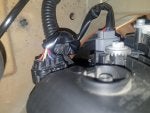SCHEDULE 5
PART I
Requirements relating to obligatory main-beam headlamps and to optional main-beam headlamps to the extent specified in part ii
1. Number–
(a) Any vehicle not covered by sub-paragraph (b), (c) or (d):
Two
(b) A solo motor bicycle and motor bicycle combination:
One
(c) A motor vehicle with three wheels, other than a motor bicycle combination, first used before 1st January 1972:
One
(d) A motor vehicle with three wheels, other than a motor bicycle combination, first used on or after 1st January 1972 and which has an unladen weight of not more than 400 kg and an overall width of not more than 1300 mm:
One
2. Position–
(a) Longitudinal:
No requirement
(b) Lateral–
(i)Where two main-beam headlamps are required to be fitted–
(A)Maximum distance from the side of the vehicle: The outer edges of the illuminated areas must in no case be closer to the side of the vehicle than the outer edges of the illuminated areas of the obligatory dipped-beam headlamps.
(B)Maximum separation distance between a pair of main-beam headlamps: No requirement
(ii)Where one main-beam headlamp is required to be fitted:
(i)On the centre-line of the motor vehicle (disregarding any sidecar forming part of a motor bicycle combination), or
(ii)At any distance from the side of the vehicle (disregarding any sidecar forming part of a motor bicycle combination) provided that a duplicate lamp is fitted on the other side so that together they form a matched pair. In such a case, both lamps shall be treated as obligatory lamps.
(c) Vertical:
No requirement
3. Angles of visibility:
No requirement
4. Alignment:
To the front
5. Markings–
(a) Any vehicle not covered by sub-paragaph (b), (c) or (d):
An approval mark or a British Standard mark
(b) A motor vehicle first used before 1st April 1986:
No requirement
(c) A three-wheeled motor vehicle, not being a motor bicycle combination, first used on or after 1st April 1986 and having a maximum speed not exceeding 50 mph:
No requirement
(d) A solo motor bicycle and a motor bicycle combination:
No requirement
6. Size of illuminated area:
No requirement
7. Colour:
White or yellow
8. Wattage–
(a) A motor vehicle, other than a solo motor bicycle or motor bicycle combination, first used on or after 1st April 1986:
No requirement
(b) A motor vehicle, other than a solo motor bicycle or a motor bicycle combination, first used before 1st April 1986:
30 watts minimum
(c) A solo motor bicycle and a motor bicycle combination–
(i)having an engine not exceeding 250 cc: 15 watts minimum
(ii)having an engine exceeding 250 cc: 30 watts minimum
9. Intensity:
No requirement
10. Electrical connections–
(a) Every main-beam headlamp shall be so constructed that the light emitted therefrom–
(i)can be deflected at the will of the driver to become a dipped beam, or
(ii)can be extinguished by the operation of a device which at the same time either–
(A)causes the lamp to emit a dipped beam, or
(B)causes another lamp to emit a dipped beam.
(b) Where a matched pair of main-beam headlamps is fitted they shall be capable of being switched on and off simultaneously and not otherwise.
11. Tell-tale–
(a) Any vehicle not covered by sub-paragraph (b):
A circuit-closed tell-tale shall be fitted
(b) A motor vehicle first used before 1st April 1986:
No requirement
12. Other requirements–
(a) Every main-beam headlamp shall be so constructed that the direction of the beam of light emitted therefrom can be adjusted whilst the vehicle is stationary.
(b) Except in the case of a bus first used before 1st October 1969, where two main-beam headlamps are required to be fitted they shall form a matched pair.
13. Definitions–
In this Schedule–
“approval mark” means–
(a)a marking designated as an approval mark by regulation 5 of the Designation of Approval Marks Regulations and shown at item 12 or 13 or 17 of Schedule 4 to those Regulations; or
(b)a marking designated as an approval mark by regulation 4 of the Designation of Approval Marks Regulations and shown at item 1A or 1B or 1F or 5A or 5B or 5F or 8C or 8D or 8E or 8F or 8M or 8N or 20C or 20D or 20E or 20F or 20M or 20N or 31A or 31D of Schedule 2 to those Regulations; and
“British Standard mark” means the specification for sealed beam headlamps published by the British Standards Institution under the reference BS AU 40: Part 4a: 1966 as amended by Amendment AMD 2188 published in December 1976, namely “B.S. AU40”.






